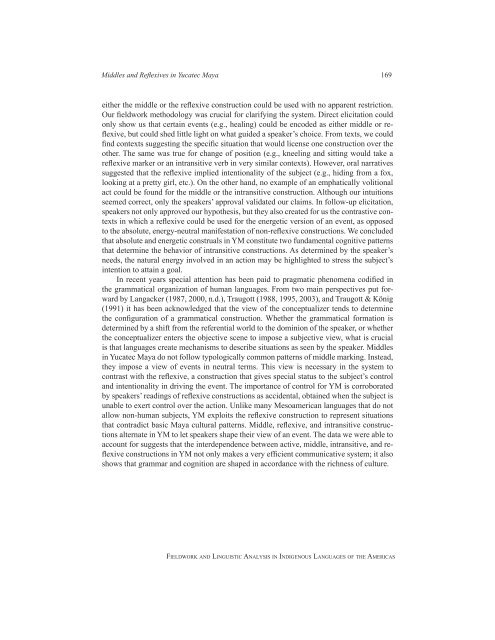Fieldwork and Linguistic Analysis in Indigenous ... - ScholarSpace
Fieldwork and Linguistic Analysis in Indigenous ... - ScholarSpace
Fieldwork and Linguistic Analysis in Indigenous ... - ScholarSpace
Create successful ePaper yourself
Turn your PDF publications into a flip-book with our unique Google optimized e-Paper software.
Middles <strong>and</strong> Reflexives <strong>in</strong> Yucatec Maya 169<br />
either the middle or the reflexive construction could be used with no apparent restriction.<br />
Our fieldwork methodology was crucial for clarify<strong>in</strong>g the system. Direct elicitation could<br />
only show us that certa<strong>in</strong> events (e.g., heal<strong>in</strong>g) could be encoded as either middle or reflexive,<br />
but could shed little light on what guided a speaker’s choice. From texts, we could<br />
f<strong>in</strong>d contexts suggest<strong>in</strong>g the specific situation that would license one construction over the<br />
other. The same was true for change of position (e.g., kneel<strong>in</strong>g <strong>and</strong> sitt<strong>in</strong>g would take a<br />
reflexive marker or an <strong>in</strong>transitive verb <strong>in</strong> very similar contexts). However, oral narratives<br />
suggested that the reflexive implied <strong>in</strong>tentionality of the subject (e.g., hid<strong>in</strong>g from a fox,<br />
look<strong>in</strong>g at a pretty girl, etc.). On the other h<strong>and</strong>, no example of an emphatically volitional<br />
act could be found for the middle or the <strong>in</strong>transitive construction. Although our <strong>in</strong>tuitions<br />
seemed correct, only the speakers’ approval validated our claims. In follow-up elicitation,<br />
speakers not only approved our hypothesis, but they also created for us the contrastive contexts<br />
<strong>in</strong> which a reflexive could be used for the energetic version of an event, as opposed<br />
to the absolute, energy-neutral manifestation of non-reflexive constructions. We concluded<br />
that absolute <strong>and</strong> energetic construals <strong>in</strong> YM constitute two fundamental cognitive patterns<br />
that determ<strong>in</strong>e the behavior of <strong>in</strong>transitive constructions. As determ<strong>in</strong>ed by the speaker’s<br />
needs, the natural energy <strong>in</strong>volved <strong>in</strong> an action may be highlighted to stress the subject’s<br />
<strong>in</strong>tention to atta<strong>in</strong> a goal.<br />
In recent years special attention has been paid to pragmatic phenomena codified <strong>in</strong><br />
the grammatical organization of human languages. From two ma<strong>in</strong> perspectives put forward<br />
by Langacker (1987, 2000, n.d.), Traugott (1988, 1995, 2003), <strong>and</strong> Traugott & König<br />
(1991) it has been acknowledged that the view of the conceptualizer tends to determ<strong>in</strong>e<br />
the configuration of a grammatical construction. Whether the grammatical formation is<br />
determ<strong>in</strong>ed by a shift from the referential world to the dom<strong>in</strong>ion of the speaker, or whether<br />
the conceptualizer enters the objective scene to impose a subjective view, what is crucial<br />
is that languages create mechanisms to describe situations as seen by the speaker. Middles<br />
<strong>in</strong> Yucatec Maya do not follow typologically common patterns of middle mark<strong>in</strong>g. Instead,<br />
they impose a view of events <strong>in</strong> neutral terms. This view is necessary <strong>in</strong> the system to<br />
contrast with the reflexive, a construction that gives special status to the subject’s control<br />
<strong>and</strong> <strong>in</strong>tentionality <strong>in</strong> driv<strong>in</strong>g the event. The importance of control for YM is corroborated<br />
by speakers’ read<strong>in</strong>gs of reflexive constructions as accidental, obta<strong>in</strong>ed when the subject is<br />
unable to exert control over the action. Unlike many Mesoamerican languages that do not<br />
allow non-human subjects, YM exploits the reflexive construction to represent situations<br />
that contradict basic Maya cultural patterns. Middle, reflexive, <strong>and</strong> <strong>in</strong>transitive constructions<br />
alternate <strong>in</strong> YM to let speakers shape their view of an event. The data we were able to<br />
account for suggests that the <strong>in</strong>terdependence between active, middle, <strong>in</strong>transitive, <strong>and</strong> reflexive<br />
constructions <strong>in</strong> YM not only makes a very efficient communicative system; it also<br />
shows that grammar <strong>and</strong> cognition are shaped <strong>in</strong> accordance with the richness of culture.<br />
fieldwork <strong>and</strong> l<strong>in</strong>guistic analysis <strong>in</strong> <strong>in</strong>digenous languages of the americas

















